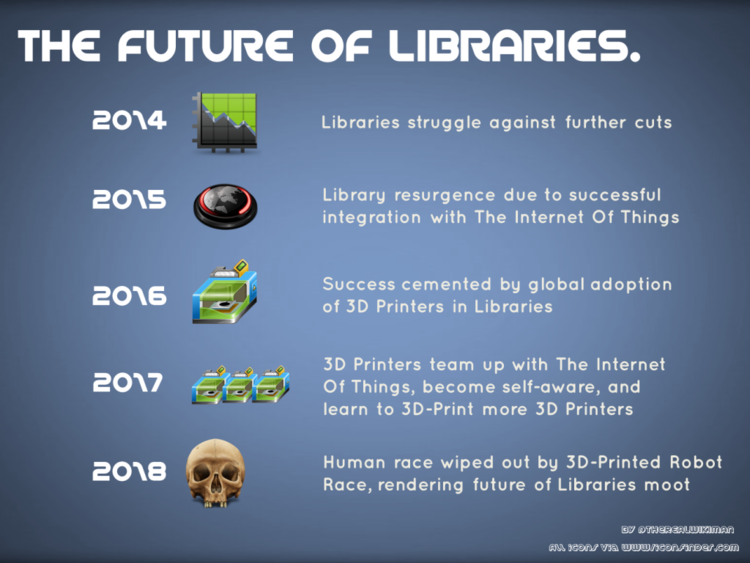Adelina Moura é professora de português e francês em Portugal há mais de 20 anos, e sabe que os seus alunos são de uma geração móvel e que na sala de aula aprendemos uns com os outros. E que usamos a conversa com proveito quando temos coisas que nos interessam de que falar - seja qual for a língua usada. Uma Conversa TED que vale a pena.
Reunir e poder voltar a ler materiais sobre ALFIN - Alfabetización Informacional, Literacia da Informação, Information Literacy. Desde 2008 To gather for later reading (again) materials on IL issues. Since 2008
terça-feira, 4 de novembro de 2014
5 FLUÊNCIAS
AS
5 FLUÊNCIAS PRINCIPAIS DA APRENDIZAGEM NO SÉC. XXI
Outubro
29, 2014
Hoje
quero partilhar convosco esta fantástica leitura com que me deparei
no Global
Citizen Education.
O título do artigo é 21st
Century Fluencies. Baseia-se
sobretudo no livro de Crockett e outros, Literacy
is Not Enough.
O
principal argumento deste texto é o de que as fluências do século
XXI são competências processuais de que os estudantes necessitam
para singrarem num mundo em rápida mudança. Estas competências
processuais incluem coisas como pensamento crítico, resolução de
problemas, criatividade, inovação, para só mencionar algumas. As
fluências do século XXI”, como nos dizem os seus autores, “não
tratam de hardware, são sobretudo headware (menteware) e heartware
(coraçãoware).”
Fonte
da imagem: http://goo.gl/GJKHzD
|
O
artigo aprofunda as cinco principais fluências. Eis uma breve
síntese de cada uma delas. Podem encontrar uma análise mais
detalhada de cada uma delas no texto
original.
"Fluência
na Solução é a capacidade de pensar de forma criativa para
resolver problemas em tempo real, definindo com clareza o problema,
desenhando uma solução apropriada, concretizando a solução e,
então, avaliando o processo e o resultado.”
Fluência
Criativa é o processo pelo qual a proficiência artística adiciona
significado através do design, da arte, e da narração de
histórias. Tem a ver com o uso do design inovador para acrescentar
valor à função de um produto através da sua forma.
"Fluência
na Colaboração é uma perícia do trabalho em equipa que atingiu,
no inconsciente, a capacidade de trabalhar de modo cooperativo com
parceiros virtuais e reais em ambiente online, para resolver
problemas e para criar produtos originais.”
"
Há dois componentes na Fluência nos Media. Em primeiro lugar, a
capacidade de olhar de forma analítica para qualquer comunicação
para interpretar a mensagem real, e para avaliar a eficácia do
mediumk escolhido. Em segundo lugar, criar comunicações originais
alinhando a mensagem e a audiência através do medium mais adequado
e efetivo.”
“Fluência
de Informação é a capacidade de, inconsciente e intuitivamente,
interpretar informação em todas as formas e formatos, de modo a
conseguir extrair o conhecimento essencial, autenticá-lo, e perceber
o seu sentido e a sua significação.”
Fonte:Blog Educational Technology and Mobile Learning
Trad. de inglês para
português Maria José Vitorino 2014.11.04
domingo, 2 de novembro de 2014
Let´s take a walk on the bright side?
Libraries: People, Place, Platform - see slides 48-52, in:
Future internet of things and librarians
A imagem a baixo é de outra fonte
Imagem de Ned Potter, aqui
"Regardless of how the future unfolds, the Internet will evolve in ways we can only begin to imagine. By allowing ourselves to explore and rehearse divergent and plausible futures for the Internet, not only do we prepare for any future, we can also help shape it for the better."
Ler mai aqui:
The Future of the Internet | Pew Research Center's Internet & American Life Project
A imagem a baixo é de outra fonte
Imagem de Ned Potter, aqui
Ler mai aqui:
OECD educationtoday: How can education systems embrace innovation?
How to square these different views on innovation in education? Maybe the core of the dispute is not so much about the actual amount of change and innovation in education, but about the process - how change and innovation happen. A lot of well-intentioned innovations fail not because of a lack of quality or because their intended direction of change is wrong, but because of how they have been implemented. Teachers will be able to give you rich accounts of top-down innovations, implemented without much consultation, without taking into account the experiences and knowledge base at the point of delivery of education. Lack of trust, lack of ownership, a poor evidence base, and lack of empowerment of the key actors – these seem to be the main ingredients of the recipe for failure in changing education.
To better understand this, we need to know more about how the governance of education systems has changed. Many attempts to bring about innovative change in education do not yet seem to be based on what we already know about how education systems are governed. Decentralisation, greater complexity, multiplication of stakeholders, broader dispersion of knowledge and expertise, more levels of decision-making all make education systems more difficult to steer and to change. At least that’s the impression one gets when looking at the system from the outside. Indeed, the complexity and the multilevel nature of decision-making in education systems make top-down reform much more difficult to achieve. But complexity, in itself, does not necessarily jeopardise change through innovation.
Subscrever:
Comentários (Atom)
-
A ALA agradeceu hoje a 4 senadores, Tom Harkin (D-IA), Patty Murray (D-WA), Sheldon Whitehouse (D-RI) and Jack Reed (D-RI) por terem conseg...



